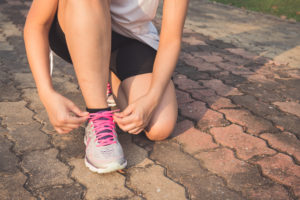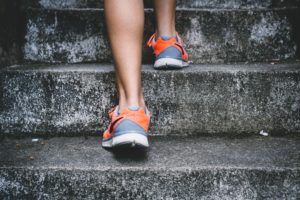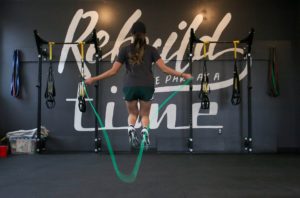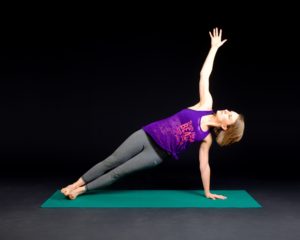
According to National Institute of Health, bone mass peaks between ages 20-30, making it crucial for individuals to actively work to maintain bone density throughout the lifespan. Bone is living tissue, constantly tearing down and building up, but when the tearing down is occurring quicker than the building up, bones lose density and begin to get larger pores or holes, making them less stable and vulnerable to injury. Someone with osteoporosis can sustain a fracture even from a seemingly harmless sneeze.
The National Osteoporosis Foundation reports that 54 million Americans have osteoporosis or weak bones. It is estimated that 50% of women and 25% of men over age 50 will break a bone due to osteoporosis! Once a fracture occurs, it can be detrimental, limiting mobility and affecting quality of life. In fact, some research has demonstrated that individuals sustaining a hip fracture die within 1 year of injury due to complications from the fracture or surgery to repair it. While many of us may feel strong now, these statistics beg us to question what we are doing now to maintain and build bone strength.
Essentially, during your youth and early adulthood, your body is able to make more bone faster than it is torn down. The Mayo Clinic describes, “The higher your peak bone mass, the more bone you have ‘in the bank’ and the less likely you are to develop osteoporosis as you age.” While the reasons for the change in bone remodeling with the aging process are still somewhat of a mystery, it is clear that taking a proactive approach now, at any stage in life, can only offer benefit.
There are several known risk factors that contribute to brittle, weak bones- some within and others out of your control:
Uncontrollable
- Gender- females have higher risk
- Age- risk increases with age
- Race- Caucasian and Asian populations have higher risk
- Family history
- Frame size- men/women with thin or petite frame have higher risk
- Increased thyroid hormone
- Some medical procedures
- Medical conditions- some gastrointestinal, autoimmune, & endocrine/hormonal disorders
Controllable
- Activity level- sedentary lifestyle/inactivity raises risk
- Calcium and vitamin D consumption
- Tobacco use
- Alcohol consumption
- Medications- corticosteroids, proton pump inhibitors and some others* increase risk
*Never discontinue the use of a medication without discussing the risks with your physician. It is important to find out all contraindications of drugs you are taking and ensure that your physician(s) has a thorough medical history. If you are concerned about how a medication may be contributing to bone loss or any health related condition, make sure to discuss your concerns with your healthcare provider(s). It is also important to understand the length of time you will be expected to take the medication and why this is a part of your treatment plan.
So, if you have osteoporosis, low bone density, or any of the risk factors, what can YOU do? AND, if you have seemingly healthy bones and are strong, able and mobile, what should YOU do to stay that way?

Improving your bone health could be as easy as taking one more step. While several risk factors are out of your control, your activity level is one that is not only within your control but is modifiable. It is well know that exercise strengthens muscles, energizes and improves tone, but it also plays a prominent role in building bone mass.
Not only do you want to build strong bones but improving muscular tone, balance and coordination is essential. Have you ever tripped and caught yourself before you hit the ground? Training our muscles to act fast and keep us upright can help us prevent falls in the first place. If you are weak, your muscles have shrunk (atrophy) and will not react as quickly or surely. Your body is amazingly designed to protect itself; keeping our muscles strong is one way it is able to perform at its peak.
We all want to create body confidence- trusting that it can and will function and perform the way it was designed.
There are several types of exercises you will want to include in your exercise routine, each having a separate but complementary purpose to maintain and increase bone density and reduce the risk of falls:
Weight Bearing Exercise
Exercises that force you to work against gravity and bear your own weight on your legs and feet:
- Walking
- Hiking
- Jogging/running
- Dancing
- Climbing stairs
- Aerobics
- Jumping rope
- Soccer

Resistance Exercise
Exercises that use your current muscular strength to strengthen muscle mass and build bone; these exercises are site specific so you are only strengthening the bone and muscles you are using in the specific movement. This means that including a variety of strengthening exercises to work major and minor muscle groups is necessary for overall body and bone strength.
- Weight lifting
- Exercise band movements
Balance Activities
Exercises that take pressure off the lower and upper back and help improve stability and muscle strength to reduce risk of falls.
- Sitting without slouching
- Bending from the hip
- Stabilizing the back when sneezing and coughing
It is a myth that those with osteoporosis should avoid participation in physical activity due to the risk of fractures. On the contrary, becoming more active may actually slow or halt the progression of the disease to maintain current bone health if not improve it. That is a pretty amazing prescription and it won’t cost a cent!!

Of course, if you have already been diagnosed with osteoporosis, check in with your physician and/or Physical Therapist for exercises that will help you get the most benefits without additional risk of fracture. And, individuals with heart disease or taking blood glucose or hypertension medications should also seek exercise clearance from a healthcare provider.
Increasing bone density is an on-going activity. Not only is it important to include a variety of these weight bearing and strengthening activities into your exercise routine, but consistency is necessary. You will continue to reap benefits if you maintain an exercise routine. As the saying goes, “use it or lose it.”
According to the Mayo Clinic, “Swimming, cycling and exercising on machines such as elliptical trainers can provide a good cardiovascular workout, but they’re not as helpful for improving bone health.” This is one reason to include a variety of activities in your exercise routine- you won’t get bored and your bones will benefit.
Exercise is beneficial in all stages of life, but the earlier you start a consistent routine, the more momentum your body has in building bone to keep them strong. In this technology age, encouraging our kids to get off the couch, put down smart devices and get moving may be absolutely essential for them to avoid this “silent disease” as an adult. We have the opportunity to lead by example.
Of course, exercise is only 1 component to healthy bones. Adequate calcium, vitamin D, and protein are essential nutritional components. Maintaining a healthy weight along with moderate consumption of alcohol and caffeine are fundamental lifestyle elements that contribute to building a solid skeletal foundation. BUT, if you could do just one thing today, go log some steps, sit up in your chair or go grab your exercise band hiding in your closet… your 80 year old self will thank you.
TRUTH: The righteous person may have many troubles, but the Lord delivers him from them all; he protects all his bones, not one of them will be broken. –Psalm 34:19-20 (NIV)
REFERENCES
- American College of Sports Medicine, http://www.ncbi.nlm.nih.gov/pubmed/7791573
- National Center on Health, Physical Activity and Disability, http://www.nchpad.org/815/4201/Physical~Activity~and~Bone~Health~~Strategies~for~Exercise~Prescription~and~Osteoporosis
- National Osteoporosis Foundation, https://www.nof.org/patients/what-is-osteoporosis/
- Mayo Clinic, http://www.mayoclinic.org/diseases-conditions/osteoporosis/home/ovc-20207808
- Academy of Nutrition of Dietetics, http://www.eatright.org/resource/fitness/training-and-recovery/building-muscle/resistance-train-to-prevent-muscle-loss
- Cleveland Clinic, http://www.clevelandclinicwellness.com/conditions/Osteoporosis/Pages/EatRighttoStopBoneLoss.aspx
- National Institute of Health
- http://www.niams.nih.gov/health_info/bone/Bone_Health/Exercise/default.asp
- http://www.niams.nih.gov/health_info/bone/osteoporosis/osteoporosis_ff.asp
- http://www.niams.nih.gov/health_info/bone/osteoporosis/bone_mass.asp
- American Osteopathic Association, http://www.osteopathic.org/osteopathic-health/about-your-health/health-conditions-library/general-health/Pages/bone-health.aspx
FREE 15 Fast Snacks that Won't Leave You Hungry

Tired of boring snacks? Want to know what to stock in your pantry and fridge to keep you fueled and satisfy cravings? Grab this yummy handout and sign up for my newsletter. Take one step today for your health!
